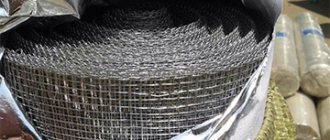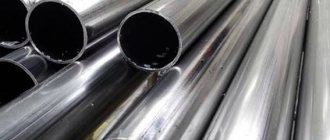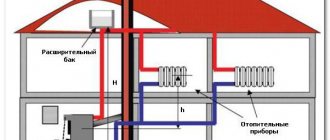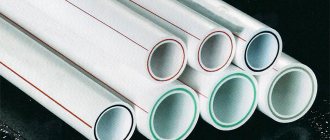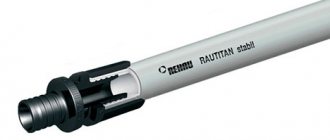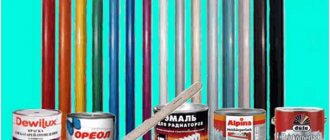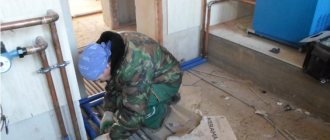For central and autonomous heating systems, a common problem is a decrease in the temperature of the coolant as it moves through the pipeline. First of all, this applies to external sections of the heating network, but also inside the building in some areas, thermal insulation of heating and hot water supply pipes is required to avoid heat loss.
You can buy a shower for your bathroom at AlmetaGroup. Variety of materials
Communications inside the house, as well as within your own land, can be insulated yourself by choosing the right materials. By insulating the heating main and hot water pipeline, you will achieve:
- reducing heat losses in areas where the heat supply pipeline is laid above ground or passes through unheated (including basement) premises;
- reducing the risk of corrosion on the outside of metal pipes;
- preventing freezing of the coolant when the boiler is stopped (freezing of the system leads to its failure due to burst pipes);
- saving money on heating the house and preparing water for hot water supply.
How to insulate heating pipes on the street
It happens that in private houses the boiler is installed in a separate room, and part of the pipeline runs outside. And here the problem arises of delivering heat to the house without large losses. To reduce heat loss, it is necessary to take care of insulating pipes, regardless of their location: in the air or underground.
If this is not done, the system will lose up to 20 - 25% of heat, and this is in the best case, and in the worst case, defrosting and damage to the system will occur. Insulated heating sections located outside will deliver more heat to the house and will be protected from temperature changes, mechanical damage and corrosion.
Insulation of heating pipes in the ground - All about insulation and energy efficiency
Factory multilayer pipes
An article about how to insulate heating pipes outdoors, indoors and when laying communications underground. The types of heat insulators and methods of their application are considered.
Why do you need to insulate communications?
Perhaps someone may wonder why insulate something that is already hot. Indeed, the heating circuit is always warm, since heated coolant circulates in it. Do not forget that all insulation for heating pipes has excellent thermal insulation properties.
The essence of insulating heating pipes is to ensure that the coolant maintains its temperature for as long as possible.
It is especially important to use insulation for heating pipes if the heating main runs through the air or underground from the place where the water is heated to the heated room. Let’s assume that the pipe is not insulated; this is extremely negative for heating.
In this case, the boiler, or a set of heaters, raises the temperature of the water in the system and directs the working fluid to the place where it should give up its heat. Such places are heated residential and non-residential areas. The coolant interacts with the walls of the circuit and heats them. And they, in turn, interact with the environment.
Requirements for insulation for heating pipes
Today, the range of heat-insulating materials is so large that you can get confused when choosing. Therefore, when choosing insulation for pipes, first of all you need to focus on its technical characteristics.
The thermal insulation material must meet the following conditions:
- low thermal conductivity;
- hygroscopicity;
- high temperature resistance;
- durability;
- easy installation.
Today, for thermal insulation of heating systems, there are many practical, easy-to-install and neat insulation materials. The following materials are very popular:
- mineral and stone wools;
- Styrofoam;
- penoizol;
- expanded polystyrene;
- polyethylene foam;
- thermal insulation paint.
All these insulation materials differ both in technical characteristics and in the installation method. Therefore, they can be divided into the following types:
The choice of one material or another depends on how the pipes are installed - their availability, etc., the financial capabilities of homeowners, the temperature of the coolant, etc.
Video: Mineral wool cylinders - installation of insulation on pipes
Roll insulation
The use of roll materials is losing its former popularity. The reason for this is more labor-intensive installation. For good thermal insulation, it is necessary to create a reliable and hermetically sealed fastening of the insulation to the pipe; the rolled material is secured with reinforced tape or wire.
A waterproofing device is also required, which leads to additional costs. And yet, despite the labor-intensive installation and additional costs, insulation with roll materials shows good results.
Casing and sectional insulation
Sectional insulation, the so-called “shell”, consists of 2 - 3 or 4 separate sections (depending on the diameter of the pipe) connected by grooves. Sections can be made of polystyrene foam, polystyrene foam, stone wool, etc. Due to the grooves, the sections are connected to each other and form a reliable and airtight coating.
Casing insulation is made of foam or artificial rubber. Its installation also does not require additional tools. It is produced both in the form of a solid cylinder, which is put on the pipes when installing the system, and in the form of sections mounted on a ready-made pipeline.
Spray insulation
Spraying insulation is probably the most ideal way to efficiently and quickly insulate outdoor heating pipes. Reliable and uniform insulation is achieved by applying it directly to the surface of the pipe.
At the same time, the complete absence of seams and joints makes it possible to insulate the junctions and branches of pipes and eliminate the formation of cold bridges. But it will be difficult to carry out insulation yourself. Application requires special equipment and experience.
Functions of insulation for heating pipes
In a private house, the heating boiler can be located either indoors (for example, in the basement) or in a separate outbuilding for utility purposes. In the second case, most often there is no centralized gas supply and solid materials such as peat briquettes, coal, pellets, and firewood are used for heating.
Often in private homes there is a sauna or bathhouse located outside. This allows you to avoid complicating the design of the heating system by the presence of a tank for heating water. The water supply must be led from the heating boiler, which can often be located at a considerable distance. When choosing a material for insulating heating pipes, the following conditions must be taken into account.
Reduced heat loss
The essence of any heat insulator and its main task is to protect the surface of the pipes from the negative influence of the environment. In this case, the reduced thermal conductivity of the insulation will reduce heat loss and the heated pipeline will cool much more slowly than in the case of uninsulated pipes.
Almost all heating mains are designed in such a way that communications pass both above and below the surface of the earth. For external pipes, a soft thermal insulator is usually used, and in the case of underground installation, a rigid insulating layer is created to compensate for soil pressure.
Eliminate the risk of freezing
If the hot water supply inside an individual heating system goes from the boiler to a building located at a considerable distance, then most often underground communications are laid. It is important that the pipes go below the soil freezing level. But if it is not possible to locate the pipeline at a significant depth, then long-term interruptions in the supply of heated water are possible if it is not used constantly. This happens because the remaining liquid in the pipes freezes in cold weather. To protect underground communications from freezing, they are insulated by protecting them with a hard shell or a shell of a soft structure, which are located inside the pipe channels.
Eliminating condensation
According to construction standards, it is prohibited to lay metal pipes under the ground without insulation or an external protective shell, which is played by auxiliary materials. Indoors things are different. There you can lay a pipeline made of ordinary steel, galvanized steel, and also copper. If the heating is turned off, the liquid cools inside the metal pipes. Drops of condensation affect the outer walls, causing them to corrode, and in large quantities can even form puddles on the surface of the floor and ruin its decorative coating. To avoid such troubles, it is recommended to use heat-insulating materials for pipes that have a porous structure and are vapor-permeable or moisture-resistant.
Advantages and disadvantages of individual insulation materials
All types of insulation have their advantages and disadvantages. Therefore, it is worth talking about the pros and cons of insulation separately.
Mineral wool
This is a classic insulation material that occupies a leading position among rolled materials in popularity. And there are several reasons for this:
- high thermal insulation rates;
- resistance to aggressive environments;
- does not rot;
- not afraid of rodents;
- can be used when insulating heating pipes with high coolant temperatures;
- low cost.
The biggest disadvantage of mineral wool is that it is hygroscopic, that is, it absorbs moisture. Therefore, when using it, a waterproofing device is required, since if it gets wet, it will lose all its properties.
Unlike rolled materials, using penoizol you can achieve seamless pipeline insulation. The advantages include:
- excellent thermal insulation - 12% higher than that of cotton wool and 8% higher than polystyrene foam;
- no additional fastening or waterproofing required;
- biologically stable (not afraid of rodents and insects).
The main disadvantage is the need for special equipment to apply it.
Expanded polystyrene
The polystyrene foam shell is pressed against the surface of the pipes and secured with tape or clamps. Each section has grooves, thanks to which a tight connection is achieved. Withstands compressive and tensile loads.
But, since the material is hygroscopic and is destroyed under the influence of carbon liquids, it will require the creation of waterproofing. Another disadvantage is the difficulty of installation when turning the main line. To give the insulation the desired shape, you have to trim it.
Polyethylene foam
This is a new generation material. The closed cell structure provides it with such advantages as:
- low thermal conductivity;
- moisture resistance;
- does not rot;
- easy installation.
Available in the form of canvas (may have one or two-sided foil coating) or tubes. Polyethylene foam is cut into strips and wrapped around the pipe. The presence of a foil layer allows you to create additional thermal insulation and a waterproofing layer.
Thermal insulation paint
A relatively young type of thermal insulation. A special formula created by Russian scientists allows you to achieve optimal results even if you apply it in a thin layer. Apply thermal paint with a brush or spray. For hard-to-reach places, this is simply an irreplaceable option. The main disadvantage is the high cost, which is several times higher than the cost of other insulation materials.
As you can see, the choice of material for insulating heating pipes on the street is great. When choosing, the first thing to pay attention to is the characteristics of the material, then the complexity of installation. Last but not least, look at the price. Remember that cheap insulation can quickly become unusable and then the money will be wasted.
Video: Thermal insulation of pipes: comparison of types
Is it necessary to insulate heating pipes and what benefits does it give?
Thermal insulation for heating pipes allows:
- reduce heat loss in places where pipes pass along the ground, are mounted by air (ground) or are located in an unheated room;
- prevent freezing of the liquid, which is the coolant (freezing is fraught with a pipe break);
- reducing the likelihood of corrosion on the surface of the pipe (for metal pipelines);
- saving money on heating your home.
Thus, the more reliably the heating system is insulated, the more heat the user will receive (the higher the efficiency), and the less he will have to pay for gas for heating (or for electricity, if an electric boiler).
Thermal insulation for outdoor heating pipes
A variety of insulation materials makes it possible to choose exactly the one that is best suited for a specific location of application (outdoors, in the ground, in the basement, in the attic) and budget.
The selection of a heat insulator is carried out taking into account the following factors:
- heating system pipe diameter;
- operating conditions (location of the heating system);
- average heating temperature of the coolant;
- thermal conductivity indicator of insulation (the lower, the better);
- water absorption rate. Shows the ability of the insulating material to perform its functions in a humid environment;
- resistance to combustion, biological and chemical activity, ultraviolet radiation and other environmental factors;
- life time;
- ease of installation (provided that sufficient tightness is ensured);
- price.
How to insulate outdoor heating pipes with your own hands
To choose the right pipe insulation, you need to know what types of thermal insulation for heating pipes exist, and what are the features of each of them.
Classification of thermal insulation materials for heating pipes
By installation method:
- rigid sheet insulation
. These include: polystyrene foam and polystyrene foam. Despite the high thermal insulation properties, the installation of such insulation is quite complicated from the point of view of ensuring the tightness of the insulation;
- roll insulation
. These include: polyethylene (used as an additional component of insulation), foil penofol, wool (mineral and glass wool). The use of rolled materials requires the arrangement of their reliable fastening to the pipe;
- segmental (shell) insulation
. There are two types of such insulation: hard - shells made of polystyrene foam, polyurethane foam (PPU) or polystyrene foam, and soft - polymer pipes. The advantage of segment materials is that they hold their shape well, are easy to install and provide the required level of tightness between the heat-insulating material and the heating pipe;
- sprayed insulation, incl.
thermal paint . Penoizol has proven itself to be an excellent sprayer, as it allows you to insulate even small cracks. Thermal paint has the same property. The only disadvantage of these materials is that they are quite expensive and applying them yourself is problematic.
Thermal insulation of heating pipes with hard, soft and sprayed insulation
By type of insulation:
- polystyrene foam and polystyrene foam
. They have the best characteristics in terms of maintaining the original temperature of the coolant. Their use in the form of a shell simplifies installation and provides reliable protection of the system;
Thermal insulation for heating pipes - foam shell Thermal insulation material for heating pipes - polystyrene foam and polystyrene foam
- wool (mineral, glass wool)
. Can be used as a roll or sectional material. Regardless of the type and configuration, cotton wool insulation for heating pipes has a significant drawback, which is that cotton wool is hygroscopic. Those. it needs additional protection from moisture. When wet, cotton wool loses its properties. Therefore, sections often have additional protection in the form of a foil layer. But cotton wool is great for insulating pipes in the basement or attic.
Thermal insulation for heating pipes - casing made of mineral wool Thermal insulation for heating pipes - casing made of foiled basalt wool
- foil penofol
. Due to its small thickness, it is used primarily for insulating pipes indoors.
Thermal insulation for heating pipes - foil penofol Insulation of heating pipes with penofol
- foamed polyethylene
– (EPE, PPE) polyethylene foam for pipes.
Thermal insulation for heating pipes - polyethylene foam (PPE) Insulation for heating pipes - polyethylene foam pipe
Comparison of thermal insulation materials for pipes - video
Heating pipe insulation technology
The choice of pipe thermal insulation and the method of its installation are influenced by the location of the pipeline.
Insulation of heating pipes on the street
External thermal insulation of pipes is the most difficult method of insulation, since in the open air it is not only the pipes that need protection, but also the insulation itself. For outdoor installation, non-hygroscopic materials or other materials are used, but reliably protected from moisture by a film or casing.
In addition, it is advisable to use the densest and thickest insulation outdoors. Another requirement is the use of a material that is resistant to ultraviolet radiation, bad weather and mechanical damage.
Insulation of heating pipes in an unheated room
Basement, cold attic, boiler room - a feature of such rooms is the absence of heating radiators. But since the pipes are filled with coolant and are located in an environment with minimal humidity, there are no special requirements for either the thermal insulation material or its thickness.
Thermal insulation of heating pipes in an unheated (cold) room
Insulation of heating pipes underground
The specificity of installing heating pipes underground is that they must be laid below the freezing level of the soil, which is a depth of one and a half to two meters. If you do not adhere to this requirement, the coolant will cool greatly while it passes through the heating main located in the ground. In order to reduce heat loss, you need to take care of high-quality insulation of the underground pipeline.
Experts say that the optimal solution in this case would be to use a cable pipe heating system. But due to the high cost, users prefer enhanced thermal insulation of heating pipes.
Good insulation of underground heating pipes requires the following requirements:
- insulation of insulation from moisture in the soil;
- eliminating the possibility of deformation of the insulation, because in this case, its properties are reduced. This is especially true for soft thermal insulation materials;
According to reviews, the optimal solution is thermal insulation of heating pipes using polyurethane foam shells.
Note. Users recommend using a combined insulation system for pipes that are laid above the ground freezing level, namely: a combination of cotton wool and a hard polyurethane foam shell with a protective fiberglass coating. Ideally, even at the installation stage, use factory-made multilayer pipes in polyurethane foam insulation.
Insulation underground
Such pipes are laid underground
Heating pipes are also laid underground. Important points when insulating heating pipes in the ground:
- bury communications below the freezing level. This indicator is individual for each region;
- prevent moisture from getting into the insulation;
- prevent deformation of the insulating layer under the weight of the earth.
Laying communications underground has always been expensive, as special attention to insulation is required.
The most common method is the use of insulation in conjunction with rigid casings. It could be:
- Communications wrapped in insulation, which are placed in plastic sewer pipes with a diameter of 110 or 160 mm. Mineral wool, foam materials or polystyrene can be used as insulation for heating pipes in the ground.
- Factory multilayer pipes.
The latter come in various configurations. The main thing they have in common is a pipe (plastic or metal), a layer of insulation and a rigid frame. The high cost of such products often becomes the reason for insulating underground heating pipes using the first method.
How to insulate heating pipes with your own hands
Sequence of actions in the form of step-by-step instructions:
- calculation and purchase of thermal insulation material;
- wrapping the pipe with foil tape or foil. The foil acts as a heat reflector;
- installing insulation around the pipe. Sectional hard (casing) or soft insulation is simply “put on” the pipe. As for soft materials, they need to be cut into pieces equal in width to the diameter of the pipe. Next, wrap it around the pipe and secure it with tape, wire or plastic clamps. Hard insulation is the hardest part. From it you need to create a box around the pipe (or use pipe shells of the appropriate diameter);
- inspect the insulated pipe for the presence of “cold bridges” and eliminate them;
- secure the heat-insulating material to the pipe using plumbing or metallized tape;
- if necessary, cover the heat-insulating material with protective material (film) and seal the joints with tape.
The costs of insulating heating pipes, despite their initial value, are quickly recouped by saving on bills for heating the house.
Insulation of pipes indoors
Almost everyone knows that it is necessary to insulate heating pipes in the basement, but many doubt the need to insulate pipes indoors. This point of view is motivated by the fact that the energy lost by the pipeline is spent on heating the same rooms.
It should be clarified that we are not talking about the wiring that ensures the connection of radiators, but about the central sun loungers and risers. So, their insulation also makes sense, since the heating source is not pipes, but batteries. This issue is especially acute in private houses, where risers are often embedded in the wall or located between drywall and the wall.
In the photo - insulated heating pipes in the room
Therefore, experts say that the bulk of the pipes, which are located even in the apartment, also need to be insulated. Polyethylene foam is usually used as insulation for these purposes. Before installation, it is cut lengthwise, which allows you to put the material on the pipe. (See also the article Thermal insulation of pipes: features.)
Advice! To ensure that the polyethylene foam is installed tightly and without gaps, tape can be applied to the joints.
Polyethylene foam
Here, perhaps, are all the aspects of insulating heating pipes outside and inside the room.
How to quickly and reliably insulate heating pipes outdoors
Very often, especially in private homes, the heat source is located outside the house. The natural desire of the homeowner is to deliver heat to the house with minimal losses. Regardless of whether the heating main is laid underground or goes through the air, care must be taken to ensure proper thermal insulation of the pipes. Ignoring this measure is fraught with at least a loss of 25% of heat. The worst case scenario is defrosting of the heating system. Let's try to figure out what materials are best to use for thermal insulation of pipelines and how to properly insulate heating pipes on the street.
How to insulate pipes in the basement of a house
Insulation of heating and water supply pipes in the basement is an important step in creating a comfortable microclimate and reducing the cost of heating premises in private and apartment buildings. In the article we will consider the insulation requirements for polypropylene pipes, whether it is necessary to insulate heating and water pipes. In this article we will show a video comparing the characteristics of pipe insulation, as well as visual video instructions for insulating communications yourself.
In private houses, communications have two vulnerable areas for freezing. These areas are located on the street when laying communications from the well to the house or in an unheated basement. If you have not insulated the basement, then it is necessary to protect the pipes in the basement of a private house from heat loss. Let's look at how and how to insulate communications on our own, and tell you what materials to use.
Criteria for choosing insulation for heating pipes
Looking into a hardware store, and even more so into a hypermarket, you can get confused by the abundance of thermal insulation materials. Moreover, this diversity is manifested both in the range of goods and in its cost. When choosing, first of all, you need to focus on the technical characteristics of the material. A good insulation must meet the following requirements:
- low thermal conductivity;
- low water absorption;
- resistance to high temperatures;
- durability;
- ease of installation.
Carrying out pipe insulation work on the street
Regardless of the chosen thermal insulation material, first of all it is necessary to prepare the surface of the pipes. Metal pipes should be treated with a primer. Before painting, the metal is cleaned of rust and degreased.
Casing and sectional insulation
Minimal labor costs are required for thermal insulation of pipelines using sectional and casing materials. Sectional insulation consists of two (for larger pipe diameters, three or four) sections with grooves for connection. They are made from polystyrene foam, polystyrene foam, and stone wool. The sections are simply connected to each other, thereby forming an airtight coating without cold bridges.
Casing insulation made of artificial rubber and other foam materials is also easy to install and does not require additional tools. Some of them are a one-piece tube that is put on the pipe during installation of the heating system. Others consist of several sections, which are placed on pipes in an already installed heating system, the joint is glued and sealed.
The advantages of this type of insulation are ease of installation, reliable insulation and no need to purchase special tools. The disadvantage is the high cost of the material.
Advice! Using aluminum tape or foil significantly reduces heat loss.
Roll insulation
The use of roll insulation is more labor-intensive, since it is necessary to ensure reliable fastening of the material to the pipe. The roll insulation is secured with reinforced tape or wire. Despite the labor-intensive work, this method of thermal insulation gives good results.
Sprayed insulation and thermal paint
One of the most effective ways to quickly and reliably insulate outdoor heating pipes is to spray penoizol. By applying the material directly to the surface of the pipe, it is possible to achieve a uniform thermal insulation layer. The absence of seams and joints allows you to reliably protect pipe connections and branches.
You won’t be able to insulate pipes this way yourself. You need professional tools and experience in performing such work.
Thermal paint is a recently emerged type of thermal insulation. The special formula allows you to get excellent results even when applied in a thin layer. You can apply the paint either with a brush or with a spray gun. In cramped conditions, the use of thermal paint is simply irreplaceable. The only negative is the price, which is several times higher than the price of rolled materials.
Do it yourself or trust the professionals
A wide range of insulating materials, as well as the ease of installation of some of them, encourages people to independently carry out work on insulating pipelines. Doing it yourself is definitely cheaper. But apparent simplicity is not a reason to refuse the services of professionals. The advantages of hiring specialists are obvious:
- correct calculation of heat loss
- assistance in the selection of materials
- professional tool
- quality assurance
The experience of specialists allows you to avoid mistakes when arranging thermal insulation. Self-respecting companies work exclusively with materials from trusted manufacturers. When choosing insulation materials on your own, preference is generally given to cheaper brands, which is fraught with problems during operation. By turning to professionals, you receive a guarantee of high-quality work performed with the elimination of shortcomings in the future (if any are discovered).
How and how to insulate outdoor heating pipes with your own hands
To achieve maximum effect in providing your home with heat, you need to know how to insulate outdoor heating pipes with your own hands. Modern production of heat-insulating materials has reached such a level that it allows the installation of protection for transport pipelines not only by specialists, but also by ordinary people. A prudent owner, before investing money, will definitely study the market for construction materials and the properties of their installation.
Is it necessary to insulate pipes in the basement of a house?
Is it necessary to insulate polypropylene pipes in the basement? If you did not insulate the strip foundation during construction. then it is simply necessary to protect communications from heat loss. If a country house is rarely used in winter, then communications may freeze, regardless of what material is used for the water supply pipe - metal-plastic, HDPE pipe or galvanized steel.
Photo. How to insulate pipes in the basement of a house with your own hands
When a cold water pipe enters a warm room, condensation will always form on it. If the pipe is insulated, you will protect the room from possible dampness. Heating pipes in the basement also need thermal insulation so as not to waste excess heat in this room, but to redirect it as much as possible to the living quarters, reducing your heating costs.
Heating system problems
In a private home, the boiler is often installed not in the main room, but in the summer kitchen. Therefore, when burning wood and coal, there is no constant circulation of hot water. If your home is equipped with a natural gas installation, then the problem is somewhat mitigated. The automatic safety and thermal control of the boiler will provide the desired temperature, but the energy consumption will increase many times over.
One of the important conditions for the readiness of the heating system for winter is a protected pipeline running through an open yard area. With minimal violation of the tightness of thermal insulation, energy losses amount to up to 25%. Additional costs will include the need to protect against damage to the circuit by corrosion, if this concerns metal pipes.
There is also the problem of material deformation, which occurs against the background of large temperature differences in the system and outside air. And the most unpleasant thing that can happen at the wrong time, when there is bitter frost outside, is damage to the integrity of the pipe. A similar situation develops when the temperature in the so-called return is insufficient. This is a pipe through which the coolant, usually water, returns from the radiators to the heating boiler. That is, in the absence of thermal insulation, water freezes and ruptures the container. Proper finishing of street sections of pipelines will protect against heat loss and emergency situations for a long period, and will save the owner’s financial resources.
Types of ready-made insulated pipes
The following thermal insulation materials are used as insulation for finished insulated pipes:
- Basalt.
- Fiberglass.
- Expanded polystyrene.
The latter material is the most common in the production of thermally insulated pipes.
Based on pipeline material, products are divided into:
- Metal.
- Plastic.
- Metal-plastic.
Most often, the insulating material is protected with a metal or plastic sheath.
Types of finished insulated pipes. From left to right: for cold water supply; for hot water supply and heating systems; for two-pipe systems; for four-pipe systems.
Which product should I choose?
Insulated steel pipes are used in hot water supply and heating systems. This is due to the fact that plastic has a limitation on the maximum temperature of use. It cannot exceed 95oC.
However, the main obstacle is the high coefficient of thermal expansion, which reaches 20 cm per 10 meters of length. And if insulated metal-plastic pipes can be used for hot water supply, since the maximum temperature does not reach the maximum permissible values, then only metal products are suitable for heating.
For ordinary water supply, insulated plastic pipes are the most acceptable option. They have a lower cost compared to metal ones, are characterized by high installation speed and a long service life.
Due to the fact that continuous production technologies are currently used, insulated HDPE pipe is supplied in coils with a total length of tens and hundreds of meters. Thanks to this, it became possible to install a water supply system with a minimum number of joints. In addition, a corrugated pipe can be used as a protective shell, allowing the pipeline to be bent along a sufficiently small radius without the use of corner connecting elements.
Pipes with heating cable
Scheme of an insulated pipe with a protective sheath
In order to eliminate the possibility of freezing of the pipeline, as well as in order to warm up the frozen area without labor-intensive excavation work to open the emergency area, an insulated pipe with a heating cable is used. In this case, it is possible to install a pipeline temperature monitoring device, which automatically turns on the heating cable when critical temperature values are reached.
Guidelines when searching for thermal insulators
Before insulating pipes, when protection is installed before the initial start-up, it is advisable to determine the volume and quality of the material. If the old insulation has depressurized, it is necessary to find out the level of damage. In the first case, you will have to spend much more money. Having a huge supply of products on the market is an absolute advantage. But the need for knowledge and understanding of the essence of the process causes certain difficulties for a beginner. When only glass wool was sold, there were no problems.
Now you can’t do without expert advice. He recommends paying attention to the following points:
- Inertness of the material to temperature changes of both the coolant and the atmosphere.
- Minimum thermal conductivity coefficient, which ensures no energy losses in the open air.
- Impossibility of fire at the maximum temperature of the pipeline.
- Maximum water repellency level to avoid freezing of the insulator.
- Reliability and ease of installation.
- Duration of operation.
An important characteristic is the maintainability of the material. Sometimes it is necessary to remove thermal insulation to carry out restoration work or change the input. Therefore, reusing the component will save additional money. An important criterion for most developers is the price level of the heat insulator. But in this matter, the absolute priority should be the quality of the product, otherwise everything will have to be redone.
Insulation options for street pipelines
Lack of qualifications and experience is not an obstacle to installation of the structure. But to be on the safe side, it is better to select products that are guaranteed to allow you to install them without difficulty. Along with the very popular roll and piece insulation products, there are now easy-to-install spray and casing insulation products on sale, the use of which for self-installation is absolutely not burdensome. These include the following materials:
- glass wool or fiberglass;
- mineral wool;
- foam rubber or polyurethane foam;
- foam insulation products, expanded polystyrene (foam);
- synthetic rubber;
- penofol, polyethylene foam.
To improve the thermal insulation properties of the substance, it is combined with aluminum foil, which becomes a kind of mirror reflector of energy. This category includes penofol, produced from polyethylene foam. Of the sprayed components for insulating pipelines in the open air, penoizol is used, which is identical in properties to polyurethane foam and special dyes. The latter are characterized by excellent heat-shielding properties. Apply paint in places with limited access.
Do-it-yourself insulation of heating pipes on the street
In cold climates, insulating outdoor heating system pipes is vital. Without high-quality insulation installed outside residential premises, the heating pipeline loses up to a quarter of its heat resources. When it comes to metal heating pipes, the lack of insulation also negatively affects their service life, since corrosion protection is not provided. Warp is another problem caused by temperature differences. And winter frosts outside often provoke the process of crystallization of the coolant, especially if the circulation rate is insufficient or the heating system is unstable.
Home heating systems that operate from boilers and stoves based on wood or coal and require constant maintenance are often turned off due to the owner’s oversight. As a result, pipes in areas unprotected by buildings simply freeze, depriving the entire house of heating and eliminating the possibility of comfortable living in it in cold weather. Quite costly emergency system restoration can be easily avoided by taking care to protect the pipeline outside before the onset of frost. Insulation of pipes will ensure stable heating of the house for many years with significant savings.
Electric heating
You can heat your home with electricity not only by installing a water system. Using electricity to directly heat rooms will be more correct and profitable. There are two options for electric heating:
- electric convectors;
- underfloor heating system;
- infrared long-wave heaters.
Heating with electric convectors
Electric convectors are less profitable compared to water heating, which uses gas as an energy carrier. However, compared to other options, their use will be cost-effective.
In addition, installing such devices is much faster than water radiators, and no pipes are required - only wires and an electrical network capable of withstanding the required power.
"Warm floor"
The use of heated floors will allow you not to use indoor shoes even in the coldest time of the year. Their advantage compared to convectors is more uniform heating of rooms.
However, “warm floors” cannot be used as the main source of heat – but there is no better option for additional heating.
Using infrared heaters
Almost the only disadvantages of using infrared radiation to heat a private home are the discomfort caused by the luminous panel and the low accuracy of power control. At the same time, among its advantages are:
- high heating rate;
- an increase in the temperature not of the air, but of the interior items;
- full automation of the equipment operation process.
Very often, especially in private homes, the heat source is located outside the house. The natural desire of the homeowner is to deliver heat to the house with minimal losses. Regardless of whether the heating main is laid underground or goes through the air, care must be taken to ensure proper thermal insulation of the pipes. Ignoring this measure is fraught with at least a loss of 25% of heat. The worst case scenario is defrosting of the heating system. Let's try to figure out what materials are best to use for thermal insulation of pipelines and how to properly insulate heating pipes on the street.
Criteria for choosing thermal insulation
Nowadays, there are many insulating materials used for insulating outdoor heating pipes. At the same time, this can be attributed to both pros and cons. When there were no insulation options other than glass wool, there was no need to think long about organizing the thermal insulation of the heating system. However, the complete lack of choice precluded achieving decent quality with ease of installation, which is quite possible in the modern world. Knowing the main factors that you should focus on when making a decision, it is easy to choose insulation suitable for any operating conditions.
Here's what you need to pay attention to:
- low thermal conductivity, ensuring minimal heat loss on the street;
- resistance to high temperatures and inability to ignite;
- low water absorption to avoid moisture ingress and condensation;
- resistance to aggressive environmental conditions that cause destruction;
- long service life of insulation;
- simple installation with the possibility of reliable fastening while ensuring tightness.
The range of modern means for insulating outdoor heating pipes is quite impressive. However, it should be taken into account that each material for pipe insulation, along with its advantages, also has some disadvantages. Therefore, the main thing when choosing is to find the optimal ratio for certain conditions. For example, if the temperature of the coolant is low, you may not pay much attention to flammability. If you have professional skills, the complexity of the installation work does not matter much. In relatively mild climates, the thermal conductivity of outdoor insulation may be higher than when used in northern regions.
Options for outdoor pipeline insulation
The variety of materials presented on the modern market allows you to do high-quality insulation of heating pipes on the street with your own hands, even in the absence of appropriate qualifications and serious experience. For craftsmen who doubt their own abilities, it is better to choose products that allow for simplified installation. Along with the once popular piece and roll materials, there are now convenient casing and spray insulation materials, which do not require special skills to work with.
Thermal insulation for outdoor heating pipes is made on the basis of different materials with suitable characteristics:
- fiberglass (glass wool);
- mineral fiber (mineral wool);
- foam rubber (polyurethane foam);
- foam plastic (expanded polystyrene, penoizol);
- polyethylene (polyethylene foam, penofol);
- artificial rubber (foam rubber).
To enhance the beneficial properties, manufacturers use heat-reflecting aluminum foil to coat the insulation. Penofol, made from polyethylene foam, belongs to this category. As a sprayed sealed layer for insulating heating pipes on the street, not only penoizol, an analogue of the well-known polyurethane foam, is used, but also a special paint with high heat-insulating characteristics. This type of insulation is convenient to use when there is no space or opportunity to apply a thick protective layer. Of course, the higher quality the material and the easier it is to install, the higher its cost.
Do-it-yourself thermal insulation installation
In most cases, it is quite possible to cope with the insulation of the heating pipeline on your own. Some materials, in particular penoizol, are applied using a sprayer, so working with them is considered the domain of professionals. But when installing roll, sheet or shell insulation, expensive equipment is not required. If we are talking about insulating metal heating pipes with rolled or piece insulation, in addition to the insulating material, it is enough to stock up on foil and reinforced tape, metal primer and galvanized wire. The only tools you need are a knife and a brush.
The cleaned metal pipe is primed with a brush to protect it from corrosion, and then wrapped in a spiral with foil tape. When choosing a foil-coated material, the use of adhesive tape is not necessary; you can immediately begin installing the insulation. The seams must be aligned and secured with wire. To achieve tightness, reinforced tape is applied over the insulation, after which the insulation process can be considered complete. Working with plastic heating pipes outdoors is simplified because they do not require priming. It is even easier to cope with the task when casing materials are used.
Thermal insulation for pipelines made of polystyrene foam is produced in the form of two halves, fixed to the pipe by aligning the grooves provided by the manufacturer. To properly insulate outdoor heating pipes, it is enough to select foam cylinders in accordance with the diameter of the pipes and carefully align the joints. This also applies to other materials produced in the form of casings. Solid tubes are placed directly on the pipes when installing a heating system from scratch. When the insulation of the pipeline on the street is carried out separately, they have to be cut lengthwise with further sealing of the seams with special glue.
The correct choice of material and high-quality installation of insulation for outdoor heating system pipelines allows you to significantly save energy costs in the future. A thoughtful approach to insulation involves carefully selecting insulation according to the required characteristics and performing installation work with strict adherence to the rules for laying the selected material. The highest quality and most convenient thermal insulation products also turn out to be more expensive, but one-time costs pay for themselves many times over in the future.
Related articles:
Types of solar collectors used for heating and hot water supply to houses, operation and installation diagrams.
Heating pipes are not easy to incorporate into interior design without knowing how to decorate the heating pipe. Meanwhile, there are spectacular and...
The heating system needs to be controlled, for this there are thermostats. At the moment there are many of them, today we’ll talk about all the available types.
Chimney for a modern stove or boiler: sandwich chimney made of stainless steel. Main advantages and disadvantages. Rules for calculating diameter and length.
From the article you will learn how to determine the direction of rotation of the circulation pump rotor and how, if necessary, make it rotate in.
Types of materials for thermal insulation
Insulation of heating network pipelines increases the efficiency of the system, reduces the load on the heating boiler, and helps save fuel. For these purposes, thermal insulation is used for pipes of various types; when choosing, you should take into account the functional features of insulating materials and the principles of their installation.
The following types of thermal insulation are distinguished:
:
- roll;
- piece;
- casing;
- sprayable;
- combined.
Types of thermal materials
Thermal insulation materials make it possible to insulate building structures, chimneys, ventilation ducts, and pipelines for various purposes. When choosing a material for insulating pipes with coolant or hot water, which are laid outside the building by ground or air, you should use insulation that is resistant to moisture. The universal properties of heat insulators, with which you can insulate heating pipes on the street and in the house, include
:
- low thermal conductivity;
- resistance to chemically active substances;
- does not corrode;
- fire resistance;
- safety for human health;
- simple installation;
- durability.
When choosing an insulating material for pipelines, the diameter of the pipe, location and operating conditions, and the operating temperature of the transported medium are also taken into account.
Foamed polyethylene
Thermal insulation for heating pipes made of foamed polyethylene is in high demand due to its affordable cost and functionality. The thermal conductivity coefficient of the material is about 0.035 W/m•K, while the material, due to its cellular structure, is lightweight and does not exert a significant load on the pipes.
Foamed polyethylene
Such insulation of heating and hot water pipelines is classified as low-flammable - without exposure to an open flame, the material self-extinguishes. When burning, virtually no toxic substances are released, so polyethylene foam is considered a safe insulation material. The material is not damaged by moisture, it is water- and vapor-tight, so this heat insulator is suitable for insulating external ground and basement communications, including those made of steel pipes.
Manufacturers offer foamed polyethylene in the form of rolled material and finished shells with an internal channel corresponding to standard pipe diameters. This fairly elastic casing has a longitudinal cut, making it easy to put on the pipe. The cut and joints are sealed with mounting tape; in difficult places, the heat pipe is insulated with rolled material, wound in several layers and secured with tape.
In addition to standard polyethylene foam, an innovative version of it is presented on the market - penofol. Its special feature is the aluminum foil outer surface. The reflective metal layer provides increased protection against heat loss. Due to their flexibility, penofol sleeves fit securely to the pipeline even in areas with sharp turns.
Thermal insulation with penofol
Foamed polyethylene and penofol are a good choice for those who want to do their own work on insulating external communications or pipes in unheated rooms. But this material is more suitable for autonomous heating systems, since it is designed for heating up to 75–80 ° C - a higher thermal effect can lead to deformation of the insulation and damage to its structure.
Expanded polystyrene
Expanded polystyrene, commonly known as polystyrene foam, is also used for pipe insulation. The material is characterized by low thermal conductivity (0.036–0.043 W/m•K depending on density) and low weight. Low water absorption and biological inertness make it suitable for use in damp environments. Due to its chemical inertness, polystyrene foam can be used with pipes made of any material. Other advantages include ease of processing (a sharp knife is enough for cutting), simple installation, and affordable price.
Due to the rigidity of foam plastic, insulation of heating main pipelines is produced in the form of molded elements - a shell of two halves of a suitable shape and diameter is put on a straight pipe, a bend or a joint of pipes.
Expanded polystyrene
Disadvantages include the flammability of polystyrene foam with the release of toxic substances. To prevent thermal insulation from spreading fire, it is installed leaving special fire breaks.
Also, foam plastic has low mechanical strength and is destroyed by ultraviolet radiation, so if it is used as insulation for heating pipes outdoors, it is necessary to cover the heat insulator with a casing made of galvanized sheet steel or aluminum. The casing is tightened using clamps or self-tapping screws, protecting the heat-insulated pipes from external influences.
The upper limit of the thermal strength of polystyrene foam is +75 ° C; when heated to higher temperatures, the thermal insulation material may become deformed. Therefore, polystyrene foam is suitable for autonomous heating systems with controlled heating of the coolant.
Mineral wool
The modern market offers innovative types of insulation, but the demand for mineral wool remains stable. This is a classic option for thermal insulation of heating mains, since the material is characterized by practicality and affordable cost.
Mineral wool
Mineral wool varies in the composition of its raw materials - the fibers are made from molten rocks, slag or glass. Slag wool retains heat worse; in addition, the material has an acidic environment and its contact with steel pipes is undesirable due to the risk of corrosion. Glass wool tends to cake and lose its shape; when installing it, you cannot do without protective equipment that protects the skin, eyes and respiratory organs from the smallest particles of glass. Thermal insulation made from stone (basalt) fiber is the most durable and effective.
Mineral wool made from glass and basalt fibers is characterized by:
- low thermal conductivity;
- fire safety (the material is resistant to fire, it is used for laying in fire breaks when thermally insulating pipelines with polymeric materials);
- resistance to aggressive environments, biological damage;
- elasticity - rolled mineral wool is easy to install.
At the same time, wool for insulation is not without a serious drawback - the fibrous material tends to absorb moisture, thereby losing its thermal insulation properties. It is important to know how to properly install a mineral wool thermal insulation shell so that the design does not reduce efficiency throughout the life of the insulation or pipe.
Thermal insulation device:
- Using long strips of rolled mineral wool, the pipeline is wrapped, paying special attention to bends and tee connections.
- Waterproofing is installed on top of the insulation - the pipe must be wrapped with dense polyethylene film (the overlap of the strips should be 400–500 mm) or roofing felt (overlap 100–150 mm), the material is fixed with wire and clamps.
- If a film serves as a waterproofing agent, installation of a protective casing made of galvanized steel sheet or aluminum is required.
Rock wool
Thermal insulation of an external pipeline using rolled mineral wool requires additional financial investments and labor costs for the installation of waterproofing and a protective casing. At the same time, there is another technology for thermal insulation of pipelines with mineral wool. It involves the use of straight and shaped shells made of stone wool with a foil heat-reflecting hydrophobic coating. To preserve the heat of the transported medium in a heating or hot water system, to prevent freezing of water in the water supply system, shells with a longitudinal cut are put on the pipes, the joints are taped with aluminum tape.
Due to the ability of mineral wool to withstand heating to extreme temperatures, using this material it is possible to carry out thermal insulation work on any heating pipelines - autonomous and central.
Polyurethane foam
In recent years, thermal insulation of pipelines with polyurethane foam has become widespread. This is a porous gas-filled polymer material for thermal insulation of pipelines with a rigid closed cellular structure, due to which the thermal insulation layer keeps its shape. Inside the cells there is carbon dioxide, the thermal conductivity of which is lower than that of air, and this ensures the lowest thermal conductivity of the insulation itself, about 0.022 W/m•K.
Also, the advantages of polyurethane foam heat insulator include:
- light weight;
- resistance to moisture, aggressive environments;
- low flammability (self-extinguishes without contact with an open flame);
- environmental safety (after hardening, if used in liquid form);
- different installation options.
Polyurethane foam
Using this material, you can thermally insulate pipes in the basement or cellar, or with your own hands, a heating pipeline on the street. In this case, ready-made polyurethane foam shells with an external heat-reflecting layer of aluminum foil are used. They are manufactured in two versions:
- in the form of a split shell (consists of two halves);
- in the form of a shell with a longitudinal cut and a special valve along the seam. Due to the adhesive layer of the valve, when installing the casing on pipes, it is not necessary to use tape to seal the cut.
When choosing how to insulate heating network pipes, if the pipeline has a complex shape (turns, junctions, units with fittings to regulate flow, etc.), you should pay attention to sprayed polyurethane foam. Its disadvantage is the need to use professional equipment. The heating pipe with sprayed polyurethane foam is covered with a metal casing on top to protect it from ultraviolet radiation.
To lay external networks, you can use a pipe immediately insulated with polyurethane foam. The pre-insulated pipeline is characterized by increased reliability and durability.
Polyurethane foam can withstand heating up to 220 °C, it can be used for insulating pipelines of central and autonomous heating systems without restrictions.
Foam rubber
Synthetic foam rubber is elastic, chemically inert, resistant to moisture and biological damage, and ultraviolet radiation. It has a thermal conductivity coefficient of about 0.038 W/m•K. Does not support combustion, safe for health.
Foam rubber
Thermal insulation materials made of foam rubber are produced in the form of sheets (including those with an adhesive surface) and finished shells with a longitudinal cut. When planning the insulation of heating pipes in the basement, you can choose a shell without an external protective layer, but for installation on street communications it is recommended to use material with an external reinforcing protective layer
.
Thermal insulation materials made of foam rubber can withstand heating up to 110 °C, they are suitable for communications of central and autonomous heating systems.
Thermal insulation paint
Ceramic liquid insulation is a modern Russian development. It is applied to pipes like regular paint, but when the composition, which includes acrylic and rubber components, ceramic and silicone capsules filled with vacuum, dries, an elastic film with decorative properties is formed.
Application of thermal insulation paint
Pipes insulated in this way not only look aesthetically pleasing, but also retain heat perfectly. The thermal conductivity coefficient of the material is only 0.0012 W/m•K.
If the choice of insulating material is thermal insulation paint, it should be taken into account that the cost of the material is relatively high. At the same time, heating pipes painted with this composition do not require additional protection. The material is resistant to external influences; it can withstand heating up to 260 °C.
